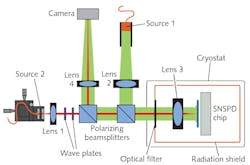Single-photon Detection: SNSPD-based system to enable free-space mid-IR secure communications

Secure quantum optical communications systems under development often rely on transmission through optical fibers. However, certain applications, such as military communications in the field, will require free-space versions of such systems. Because of atmospheric transmission windows in the mid-infrared (mid-IR; for example, at a wavelength around 10 μm), they will require high-speed mid-IR single-photon detectors.
Superconducting nanowire single-photon detectors (SNSPDs) are potentially a fit for such an application, as SNSPDs are high in speed and resolution. However, no free-space single-photon-detection systems coupling to an SNSPD have previously been created that operate in the mid-IR.
Now, a group at the Massachusetts Institute of technology (MIT; Cambridge, MA) has developed a cryostat and optical system, along with a SNSPD, with the aim to create such a mid-IR system. As a step along the way, they have already demonstrated this system at the near-infrared (NIR) wavelength of 1.55 μm (which in itself has never before been used in a high-efficiency free-space cryogenic system with a SNSPD).
Cryostat and optical system
Because of the low base temperature of less than 2 K required for a mid-IR single-photon optical communications system, the cryogenic system—which has to reach this temperature, even though it has an optical window—is a crucial part of the setup. The cryostat consists of two assemblies, one of which is mainly responsible for cooling the system, and the other of which contains the SNSPD chip and a lens. Because this second assembly is directly mounted to an optical table, alignment can be done before cooling the entire system down.
The system is precooled to 2.9 K with a pulse-tube cryocooler and further cooled to 1.7 K with a sorption refrigerator. Because the pulse tube vibrates, the SNSPD chip is mechanically isolated from the pulse tube. Use of oxygen-free, high-thermal-conductivity (OFHC) copper contacted with vacuum grease (which conducts heat well) for many parts ensures maximum effectiveness in cooling. A radiation shield and a 10-layer superinsulating shield help minimize the heat load from the external environment.
The cryostat's optical window is 25 mm in diameter. Two optical filters limit unwanted light, which, along with heating the SNSPD chip too much, would add unwanted optical noise.
Light is brought to the chip using three lenses (including the one inside the cryostat). The resulting field of view at the chip is about 200 μm. The 1.55-μm-wavelength test beam (a surrogate for the ultimate mid-IR beam) is 12.7 mm in diameter. The optical characteristics of the entire system were designed for a straightforward transition to the desired 10 μm wavelength (see figure).
The researchers used a fiber-coupled coherent light source as a signal. The optical system was designed to accommodate a niobium nitride (NbN) SNSPD with a 15 μm2 active area using 80-nm-thick nanowires with a 40% fill factor. To underfill the detector with a focal spot size of 7.5 μm at the ultimate design wavelength of 10 μm, the final lens in the cryostat has a numerical aperture (NA) of 0.41 and is an asphere.
Results
A demonstration experiment was run using a smaller NbN SNSPD with a size of 8 × 7.3 μm, and with 100-nm-thick nanowires and a 50% fill factor. The system-detection efficiency (SDE), which is defined as the ratio between the photon count rate (excluding dark counts) measured by the detector and the photon flux measured at the fiber-optic source, was determined as a function of the bias current of the SNSPD. The SDE reached a maximum of 1.64% when the bias current approached the detectors switch current. Because the optical system had a coupling efficiency of 56.5%, the detection efficiency of the SNSPD itself was about 2.9%.
The researchers have numerous improvements planned, including further optimizing the optical system with respect to the detector, further optimizing the cryostat and the chip mount's thermal properties, and the use of a tungsten silicide (WSi) for better sensitivity in the mid-IR. Upgrading the setup to a multichannel configuration could allow 100 Mbit/s data transmission in the mid-IR for use not only for secure communications at sea between vessels, but even for space-to-earth communications.
REFERENCE
1. F. Bellei et al., Opt. Express (2016); doi:10.1364/OE.24.003248.

John Wallace | Senior Technical Editor (1998-2022)
John Wallace was with Laser Focus World for nearly 25 years, retiring in late June 2022. He obtained a bachelor's degree in mechanical engineering and physics at Rutgers University and a master's in optical engineering at the University of Rochester. Before becoming an editor, John worked as an engineer at RCA, Exxon, Eastman Kodak, and GCA Corporation.